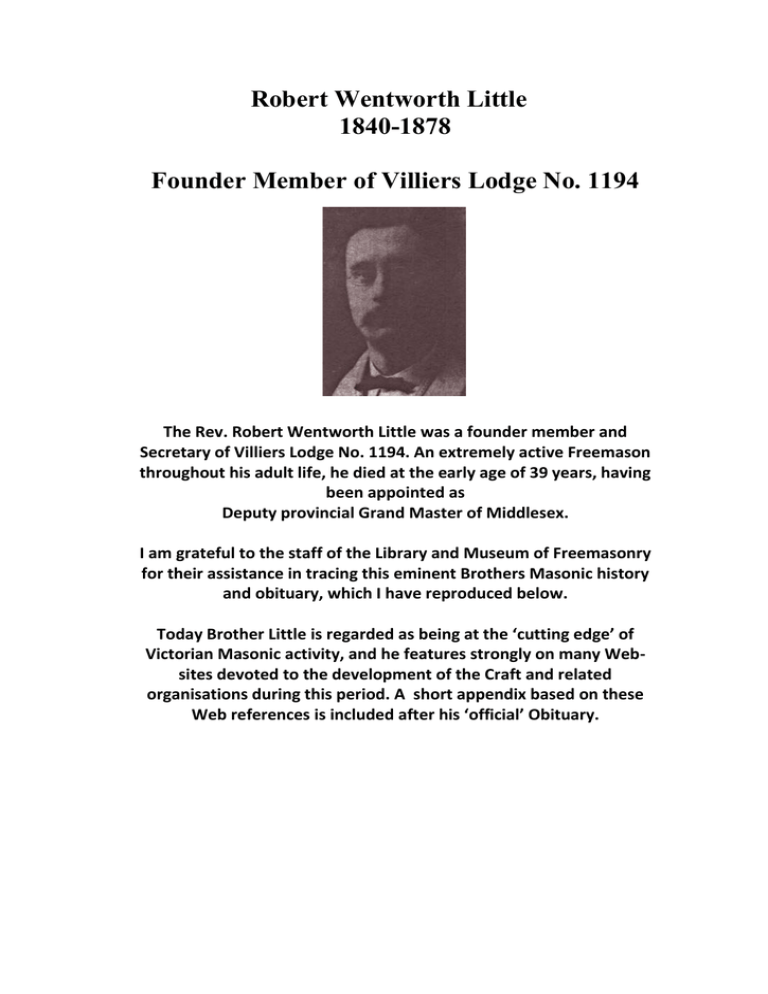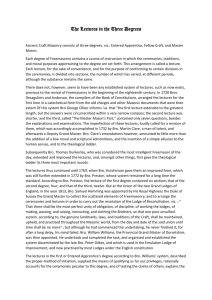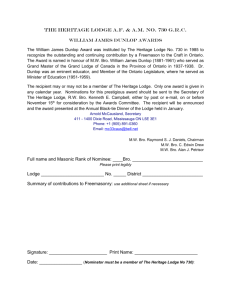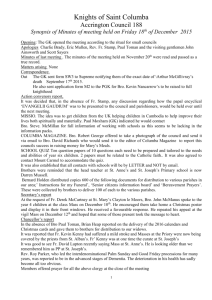Robert Wentworth Little Website version.
advertisement

Robert Wentworth Little 1840-1878 Founder Member of Villiers Lodge No. 1194 The Rev. Robert Wentworth Little was a founder member and Secretary of Villiers Lodge No. 1194. An extremely active Freemason throughout his adult life, he died at the early age of 39 years, having been appointed as Deputy provincial Grand Master of Middlesex. I am grateful to the staff of the Library and Museum of Freemasonry for their assistance in tracing this eminent Brothers Masonic history and obituary, which I have reproduced below. Today Brother Little is regarded as being at the ‘cutting edge’ of Victorian Masonic activity, and he features strongly on many Websites devoted to the development of the Craft and related organisations during this period. A short appendix based on these Web references is included after his ‘official’ Obituary. The following Obituary was published in ‘The Freemason’ June 4th 1904 An Account of Bro. Robert Wentworth Little, P.M.. &c In response to the request of a correspondent, and the view of the fact the Prov. Grand Lodge and Prov. Grand Chapter of Middlesex are about to be held, we reprint the following from our columns of April 20th 1878, concerning Bro. R. Wentworth Little, who was first Prov. Grand Secretary and afterwards Deputy Prov. Grand Master Middlesex: We give to day an obituary of our late lamented Bro. R. W. Little, which obtained from the best authorities, is we believe strictly accurate. If it errs at all, it hardly does justice to the Masonic labours of our esteemed and indefatigable Brother. Bro. Little died as he lived, in Masonry. Bro. Little was initiated into Freemasonry on the 20th of May 1861, in the Royal Union Lodge meeting at Uxbridge. He was the founder of the Rose of Denmark Lodge, No. 975 of which he became the second Master, and held the office of Secretary until 1875. He was the founder of the Villiers Lodge No. 1194, and held the office of Secretary for several years. He was also the founder and P.M. of the Burdett Lodge No. 1193, at Hampton, and held the office of Treasurer at the time of his death. Bro. Little joined the Royal Albert Lodge, No. 907, in 1862, but resigned in 1866. In the following year, 1867, he joined the Whittington, in which Lodge he held the office of Secretary until 1875. He joined the Polish National, No. 534, in 1876, and remained a member until his death. Bro. Little was exalted, and passed the chairs in the Domatic Chapter, No. 177, in 1863He was founder and first H in the Rose of Denmark Chapter, No. 975 and also founder of the Royal Middlesex Chapter, No. 1194, and was S.E. until 1874. Bro. Little was appointed to a clerkship in the Grand Secretary’s office in 1862, and became second clerk and cashier in 1866, in which position he remained until he was elected Secretary of the Royal Masonic Institution for Girls in November, 1872. There were four candidates for this office, which necessitated an election, the result of which was as follows: Bro. Robert Wentworth Little “ W. Howley Burder “ H. W. Durnford Green “ Joseph Lockington Potter 317 12 2 1 Bro. Little was originally educated for the Church under Bro. The Rev. B. Gibson, M.A., but deciding on a secular career he entered the Civil Service of the Crown in the Emigration Department at Dublin, and received testimonials of the highest character, both from his reverend tutor and his official chiefs. The following is a copy of the testimonial Bro. Little received from the hands of our esteemed Grand Secretary on his nomination for the Secretaryship of the Girl’s School. Freemasons Hall, London, W.C. November 12, 1872 “Having been asked to express my opinion of the qualifications of Bro. Robert Wentworth Little, I beg to say that, during the period I have held the appointment of Grand Secretary, I have found his conduct such as to merit my warm approval. I have the utmost confidence in saying that, to abilities of a very high order, he unites the indispensable attributes of accuracy, attention and trustworthiness, and I believe him to be well fitted for carrying out the duties of any office, however confidential, to which he may aspire” (Signed) John Hervey G.S. No one we think, will deny that the Royal Masonic Institution for Girls has greatly benefited by the energetic and wise manner in which Bro. Little administered his duties as Secretary while he was blessed with health and strength. The income of the Institution during his term of office showed a considerable increase on previous years, mainly owing to Bro. Little’s activity. Our late brother was the first Provincial Grand Secretary of Middlesex, Prov. S.G. Warden 18765, and was appointed W. Deputy Provincial Grand Master of Middlesex, which office he held until the time of his death. In 1875 he was H. of the Prov. G. Chapter, which he was instrumental in getting established. He was a member of many Preceptories, Conclaves and others of the higher grades, amongst which he was principally instrumental in resuscitating the Order of the Red Cross of Rome and Constantine. The Knights of the Holy Sepulchre in England, in which he was ever an active and hardworking member, having held the various offices of Grand Recorder, Grand Treasurer, etc., and under his able management the degree spread into almost all parts of the world where the English Language is spoken. He was an honorary member of about ninety lodges, chapters and others, many of which he was the Consecrating Officer appointed as such by the M.W.G. Master. The Rosicrucian Society was also revived by his instrumentality some years ago, and is now working in Ireland and Scotland, and there are Collages in many of the large centres of England. He was Supreme Magus of the Order, in which he has been succeeded by his next in command, Bro. Dr. Woodman. Our deceased Brother was editor of the Rosicrucian, and the author of many interesting and important works on Freemasonry. He was sincerely esteemed for his many genial qualities, which endeared him to all with whom he came into contact, and his loss will be deplored by a large circle of sympathising friends. Our lamented Brother, after a long and painful illness, consumption, passed away to his rest on Friday night, April 12th. We are permitted to add (though perhaps, it is not always desirable to raise the veil which shrouds the death-bed of men) that our late friend and Brother passed away in a deeply religious and reverential frame of mind, full of trust and faith and hope and repentance, in charity with all men. His end emphatically was peace! The entire sympathy of the Craft will be offered, with heartfelt sympathy to his afflicted widow. Bro. Wm. Dodd of the Grand Secretary’s office is his executor. The funeral of Bro. Little took place on Wednesday at the Cemetery of St. Giles, Camberwell, Honor Oak, Forest Hill, a burial ground which the deceased Brother frequently expressed his wish to be buried in as he viewed it from the Chatham and Dover Railway when he went down by that line to the Crystal Palace. The funeral, which was of a very simple character, consisted of a hearse and pair, one mourning coach, and a private carriage. The cortege left the deceased’s home in Stockwell shortly after eleven o’clock and arrived at the cemetery in time for the interment to be conducted at high noon. The Brethren present comprised Bros. S. Rawson, Past District Grand Master for China; Colonel Creaton, P.G.D., Vice-Patron and Trustee of the Royal Masonic Institution for Girls; Col. Peters, W. Mann, J. Coutts, P.G.P.; W. Roebuck, George Kenning, P.M. 192; Rev. Dr. Brette, W.M. 1657; H. Massey (The Freemason), H. Browse, P.G.D., W. Paas, J. Boyd, P.G.P.; Herbert Dickett, J. Terry, Secretary of the Royal Masonic Benevolent Institution, Prov. G.D.C. Herts; B.H. Swallow, W.F.C. Moutrie, Raynham W. Stewart, P.G.D.; Rev. P.M. Holden, Rev. J.M. Vaughan, H.C. Lavander, P.G.S. Middlesex; C.F. Hogard, John Mason, George Adamson, P.P.A.G.D.C. Kent; H. Muggeridge, late collector of the Girls’ School; A. Haynes of Liverpool, representative of the Province of West Lancashire; H.A. Dobois, James Stevens, James Spilling, F. Keily, P.Prov. G. Treasurer Middlesex; E. Letchworth, George Bolton, Charles Hammerton, George Faulkner, A.H. Tattershall, E.H. Thiellay, W.H. Hubbard, P. Prov. G. Supt. of Works Middlesex; Thomas W. White, Thomas Cubitt, P.G.P.; Thomas Kington, W. Stephens, G.J. Robinson, Province of York; Charles Atkins, P.M. 27, Secretary 1260; and J. Gilbert, Prov. G. Tyler Middlesex. The Brethren went by the 11.8 a.m. train from Ludgate-Hill, and met the funeral at the gates of the cemetery. In the mourning coach were Bros W. Dodd (executor), A.A. Pendlebury, Dr. Woodman of Exeter, Bro. Allen, and Bro. F.R.W. Hedges. In the private carriage were Bro. The Rev. Dr. Brette of Christ’s Hospital and bro. George Kenning. The coffin was of polished oak with black iron handles. On the plate was inscribed the deceased’s name, date of death and age. The lid was covered with a cross and circles composed of exquisite camellias and roses, placed there by the Brethren who occupied seats in the mourning coach. The impressive burial service was beautifully read by the Rev. J.W. Mills Ellisen, Chaplain of the Royal Masonic Institution for Girls. On leaving the chapel the Brethren marched in procession to the grave, which is situated a short distance behind the chapel. Immediately about the grave stood the Rev. J.W. Mills Ellison, Bro. Dodd, Bro. Hedges, Bro. Pendlebury, Bro. Allen, Bro. Woodman, the Rev. Dr. Brette and Bro. George Kenning. The other Brethren stood in close proximity at the two sides and the foot of the grave. The coffin was then lowered into the grave, and the Rev. J.W. mills Ellisen completed the service in the same impressive style as he had read the portions in the chapel. When the ceremony was concluded, all the Brethren advanced to the edge of the grave, took a last, long, lingering look at all there was to be seen of an old, dear friend of all of them, scattered sprigs of acacia on the coffin, and with a sincere sigh of regret for the loss they and the Masonic Order had sustained, left to his last Earthly home, Bro. Robert Wentworth Little. Wednesday, 22 October 2014 saw the dedication of the restored memorial to Robert Wentworth Little in Camberwell Old Cemetery. Readings were delivered by Graham Flight, Grand Sovereign of the Red Cross of Constantine and John Paternoster, Supreme Magus S.R.I.A. The Revd Frank A Chappell, Grand High Prelate, offered the Prayers and a Blessing and provided the words for the ceremony. If you would like to visit the address is Camberwell Old Cemetery Forest Hill Road, Forest Hill, London SE22 0RU . Grave 5734 – Square 58. Appendix 1 Some Masonic Orders connected to W.Bro. Wentworth Little. THE MASONIC AND MILITARY ORDER OF THE RED CROSS OF CONSTANTINE The Masonic and Military Order of the Red Cross of Constantine is one of seven Masonic orders governed from Mark Mason Hall, situated at 86 St James’s Street London. The Red Cross additionally incorporates, as appendant orders, the Orders of the Holy Sepulchre and of Saint John the Evangelist. The orders consist of five ceremonies, three involving the admission of the candidate and two dealing with the “chair degrees”. The whole has been described as the third pillar of Christian Freemasonry. The earliest record of the Red Cross of Constantine was in the late 1700s, in Scotland, when the three admission ceremonies formed part of a 46 degree Rite. Rituals relating to the Red Cross were also being sold in London at the beginning of the 19th century but there was no regular Masonic authority controlling the degrees until 1865 when a Grand Imperial Conclave was established, due in no small measure to the work of Robert Wentworth Little The front page of “The Red Cross Song” written by Robert Wentworth Little is on permanent display in the Museum of Freemasonry, Great Queen Street. THE SOCIETAS ROSICRUCIANA IN ANGLIA In 1866 Little founded the Societas Rosicruciana in Anglia. SRiA members were also required to be Master Masons first. The S.R.i.A concerned itself with research. An Historian for the Society writes: The main personality in our beginning is Robert Wentworth Little (1840 - 1878) who basically founded and organized the Society in 1866. R.W. Little became the first Supreme Magus and his certificate is dated December 31, 1866. (The minutes of the first meeting however are dated June 1, 1867.) He undoubtedly had counsel from others including Kenneth Mackenzie. There are many names associated with the beginning years of our Society that have contributed much to Masonic history. The grade structure seems to go back to a society founded in 1757 by Hermann Fictuld (Gold- und Rosenkreuz). The structure was first published in 1781 in the book The Rosicrucian in his Nakedness (Der Rosenkreitzer in Setner Blosse). It is thought that the rituals were found in the Grand Lodge library and translated from the German by William Henry White for Robert Little. When Little died at age 39 in 1878 he appointed Dr. William R. Woodman (1828-1891) to succeed him. And when Woodman died in 1891 he in turn appointed William Wynn Westcott (1848-1925) who held the office till his death in 1925. These latter two, Woodman and Westcott, along with another S.R.I.A. member, Samuel L. Mathers (1854 - 1918) founded another society in 1888 designed to take these rites to an even deeper and more symbolic level. This society was called the Hermetic Order of the Golden Dawn. By 1893 there were 5 temples in operation. Many of the members were drawn from the S.R.I.A., but they also allowed women members. In the spring of 1875 the Society's affairs were in a state of mild confusion. R.W. Little was threatening to resign and Dr. Woodman was living at Exeter and too far away to be able to intervene effectively. As for Little (according to Mackenzie on 9 April 1875): '... he has so many irons in the fire it is impossible for him to keep them all right. If he would take things more coolly and not waste so much of his time in the Refreshment Room at Freemasons' Hall it would be better.' THE ANCIENT AND ARCHAEOLOGICAL ORDER OF DRUIDS The Ancient and Archaeological Order of Druids was founded in 1874 by Wentworth Little. The druidic order was designed as an exclusively Masonic society. All of its members had to have reached the degree of Master Mason before joining. The purpose of the Ancient and Archaeological Order was to study the connections between Freemasonry and the druid tradition.


